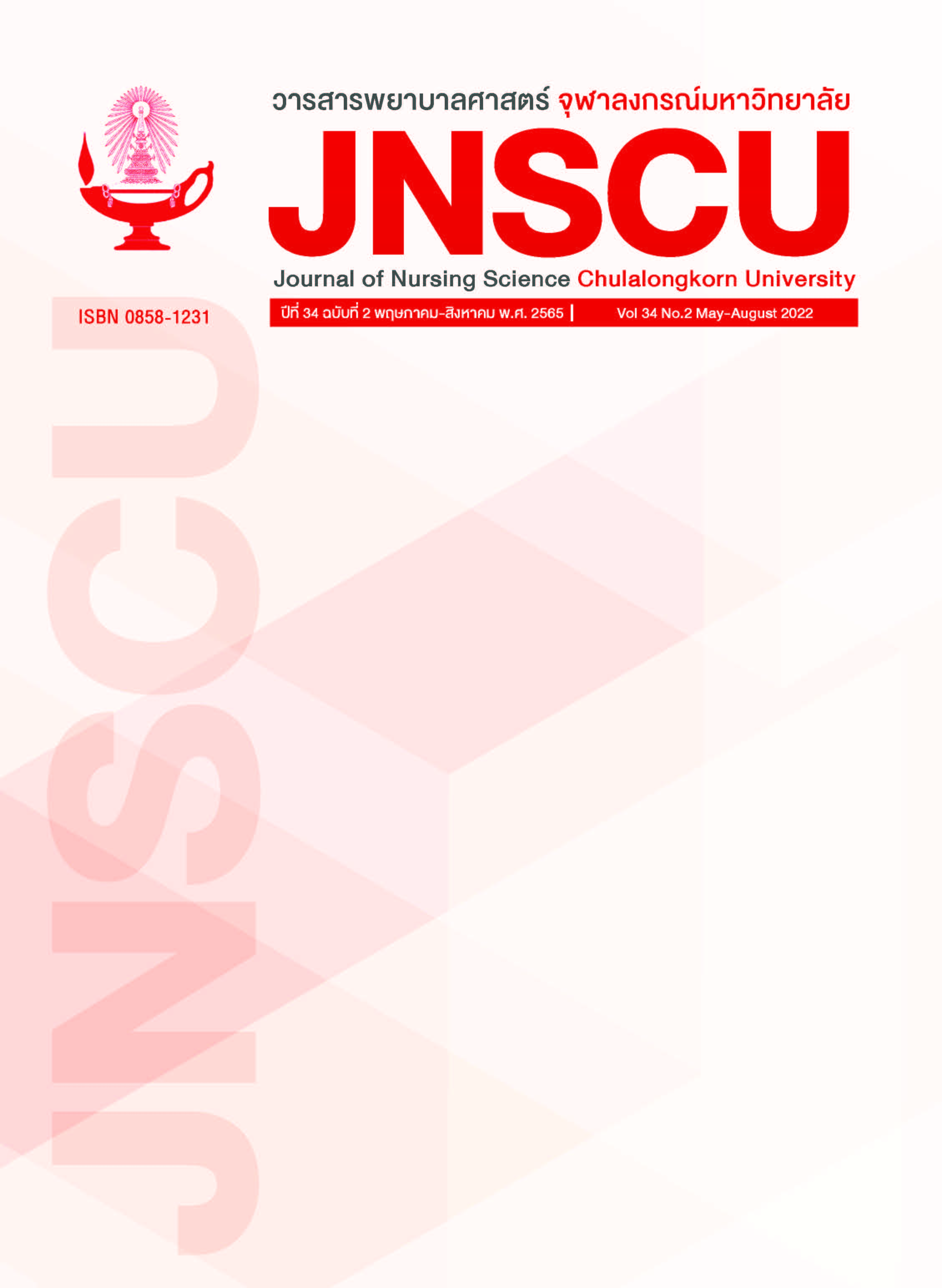ผลการให้ข้อมูลผ่านไลน์ต่อความวิตกกังวลหลังผ่าตัด ทำทวารเทียมในผู้สูงอายุโรคมะเร็งลำไส้ใหญ่และทวารหนัก
คำสำคัญ:
วิตกกังวล, ทวารเทียม, มะเร็งลำไส้ใหญ่และทวารหนัก, ไลน์บทคัดย่อ
วัตถุประสงค์: 1) เพื่อเปรียบเทียบความวิตกกังวลหลังผ่าตัดทำทวารเทียมในผู้สูงอายุโรคมะเร็งลำไส้ใหญ่ และทวารหนัก ก่อนและหลังให้ข้อมูลผ่านไลน์ และ 2) เพื่อเปรียบเทียบความวิตกกังวลหลังผ่าตัดทำทวารเทียมในผู้สูงอายุโรคมะเร็งลำไส้ใหญ่และทวารหนัก ระหว่างกลุ่มทดลองที่ให้ข้อมูลผ่านไลน์และกลุ่มควบคุมที่ได้รับการพยาบาลตามปกติ
รูปแบบการวิจัย: การวิจัยกึ่งทดลอง
วิธีดำเนินการวิจัย: กลุ่มตัวอย่าง คือ ผู้ที่มีอายุเกิน 60 ปีบริบูรณ์ขึ้นไป ที่ได้รับการวินิจฉัยจากแพทย์ว่าเป็น มะเร็งลำไส้ใหญ่และทวารหนัก เข้ารับการรักษาด้วยวิธีการผ่าตัดทำทวารเทียม ในโรงพยาบาลจุฬาลงกรณ์ สภากาชาดไทย จำนวน 44 ราย แบ่งเป็นกลุ่มทดลองและกลุ่มควบคุม กลุ่มละ 22 ราย โดยจับคู่ให้
กลุ่มตัวอย่างมีความคล้ายคลึงกันในเรื่องชนิดของทวารเทียม (ชั่วคราวและถาวร) กลุ่มควบคุมได้รับ
การพยาบาลตามปกติ กลุ่มทดลองได้รับโปรแกรมการให้ข้อมูลผ่านไลน์ ซึ่งโปรแกรมนี้ผู้วิจัยพัฒนาขึ้น โดยประยุกต์ใช้ทฤษฎีการปรับตนเองของ Leventhal และ Johnson เครื่องมือที่ใช้ในการเก็บรวบรวมข้อมูล คือ แบบประเมินความวิตกกังวลแบบเผชิญ มีค่าสัมประสิทธิ์แอลฟ่าของครอนบาค เท่ากับ .80
วิเคราะห์ข้อมูลโดยใช้สถิติเชิงพรรณนา สถิติทดสอบค่าทีและสถิติทดสอบค่าเอฟ
ผลการวิจัย: 1) ความวิตกกังวลหลังผ่าตัดทำทวารเทียมในผู้สูงอายุโรคมะเร็งลำไส้ใหญ่และทวารหนัก หลังให้ข้อมูลผ่านไลน์ต่ำกว่าก่อนให้ข้อมูล อย่างมีนัยสำคัญทางสถิติที่ระดับ .05 และ 2) ความวิตกกังวล หลังผ่าตัดทำทวารเทียมในผู้สูงอายุโรคมะเร็งลำไส้ใหญ่และทวารหนัก กลุ่มทดลองที่ให้ข้อมูลผ่านไลน์ ต่ำกว่ากลุ่มที่ได้รับการพยาบาลตามปกติ อย่างมีนัยสำคัญทางสถิติที่ระดับ .05
สรุป: ผลการให้ข้อมูลผ่านไลน์ต่อความวิตกกังวลหลังผ่าตัดทำทวารเทียมในผู้สูงอายุโรคมะเร็งลำไส้ใหญ่ และทวารหนัก สามารถลดความวิตกกังวลของผู้ป่วยและดีกว่าการพยาบาลตามปกติ
ดาวน์โหลด
เผยแพร่แล้ว
ฉบับ
ประเภทบทความ
สัญญาอนุญาต

อนุญาตภายใต้เงื่อนไข Creative Commons Attribution-NonCommercial-NoDerivatives 4.0 International License.
ลิขสิทธิ์ของบทความที่ตีพิมพ์เป็นของวารสารพยาบาลศาสตร์ จุฬาลงกรณ์มหาวิทยาลัย ทั้งฉบับตีพิมพ์เป็นรูปเล่มและเอกสารออนไลน์



